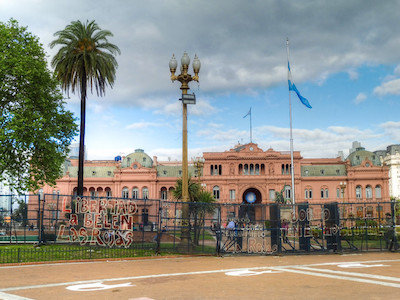
There are 22 species of albatross, who use the largest wingspans of any bird to fly for 5-6 years out over the open ocean. One of those species, the waved albatross, nests in only one place in the world: along these cliffs on Espanola Island in the Galapagos.

Albatross accomplish these long journeys often without flapping their wings, eating fish to fuel themselves for an eventual return home to find a mate. I was fortunate enough to capture photos of them during their return for breeding season as part of my trip to Galapagos with Andando Tours.

Waved albatross lay one single egg, a large brown one, without having to worry about predators since they have none on Espanola. Some young albatross though are still cautions, this one keeping an eye on a resting hawk, half its size, nearby.

Albatross are born a bit goofy looking – actually a bit Big Bird looking – but no, the rumors are not true.

They can be as cute as the nearby sea lion pups (some down by the beach on Espanola) and will mature over the next 10 months or so.

As their flight feathers begin to grow in, you’ll see them along the cliffs opening their 2.5 meter (8 foot) wings to catch the strong winds whipping about. They’ll practice this pre-flight ritual many times, before taking off over the edge.

Their maiden voyage will be a long one of several years and 17,000 kilometers (10,000 miles) or more. Resting half their brains at once and using micro-sleeps, albatross spend their waking hours hunting fish and squid on a dangerous journey.

Of the 22 species of albatross, 17, including the waved albatross, are endangered. Although their nesting grounds are well protected in the Galapagos, out at sea fisherman using over 100 kilometers of baited hooks (long-line fishing) inadvertently drown an estimated 100,000 seabirds annually. The albatross is one of these birds, who also have to worry about fisherman hunting them directly as well, they’re often eaten by fishing crews illegally.

Back on land they’ll find a mate, who will be their partner for life. Well, mostly. Biologists have noted many albatross, if given the chance, will cheat on their partners. To get a mate in the first place though, male albatross use their beaks to passively sword fight. Facial fencing is also the language of get out of my way – yet it’s so gentle you can hardly take these guys seriously.

Albatross on land are delightfully awkward but simultaneously majestic. Despite their size, they weigh only 4.5 kilograms (10 pounds) but still need a substantial runway of about 1-3 meters (5-10 feet) to land safely back home.
Which is here, the only place the waved albatross can be found, perfectly adapted to these cliffs.

Seeing these albatross took my breath away unlike any other wildlife I’ve seen before. Wandering around the cliffs, gigantic birds start popping up from behind the rocks everywhere. An airport for albatross who couldn’t care less you’re around. Despite the Galapagos Islands being full of various birds, beautiful landscapes, and animals without a healthy sense of fearing humans, the albatross stands out as an impressive manifestation of evolution on Earth.












A big shout out to Andando Tours (https://www.visitgalapagos.travel/) for getting back to me with some reputable conservation resources in the Galapagos Islands. Yesterday I noted that 17 of the 22 albatross species are currently endangered. For those of you who want to learn more about conservation efforts in the Galapagos Islands and contribute, I’m posting those resources below:
Charles Darwin Foundation
https://www.darwinfoundation.org/en/
(They have active research projects such as: Conservation of Threatened Populations of Small Land Birds, Population Status, Habitat Usage, Connectivity, and Migration Routes of Sharks, Population Assessment of Marine Birds and other 14 projects.)
WWF
https://www.worldwildlife.org/places/the-galapagos
(They dedicate their efforts in the marine reserve. They focus on teaching and preparing fishermen to fish responsibly and they monitor continuously the marine reserve to check on illegal fishing there.)
Galapagos Conservancy
https://www.galapagos.org/
(Galapagos conservancy is a US organization that has been working over 30 years on the preservation of the biodiversity of Galapagos. This organization focus on a technical way as they prepare the teachers in Galapagos, create awareness to the inhabitants of the islands in order to build a sustainable society that will not harm the Galapagos.)
Galapagos Conservation Trust
https://galapagosconservation.org.uk/
(This is a UK charity that focus only in the Galapagos conservation and sustainability. They’ve been around for 20 years. They focus on many areas in the Galapagos, but mostly they create programs to preserve the population of endangered species, and to educate the Galapagos inhabitants.)
WildAid
https://wildaid.org/protecting-the-galapagos-with-angermeyer-cruises/
(This organization focus their efforts into fighting the illegal trade of wildlife. In the case of Galapagos they focus in protecting the Galapagos marine reserve from illegal fishing. Andando donate a charter cruise on M/Y Passion every year for their annual charity ball and they also donate $100 USD per passenger on board our luxury yacht M/Y Passion.)
The Galapagos National Park Directorate
http://www.galapagos.gob.ec/voluntarios/
(The Galapagos National Park has a volunteer program in Galapagos.)